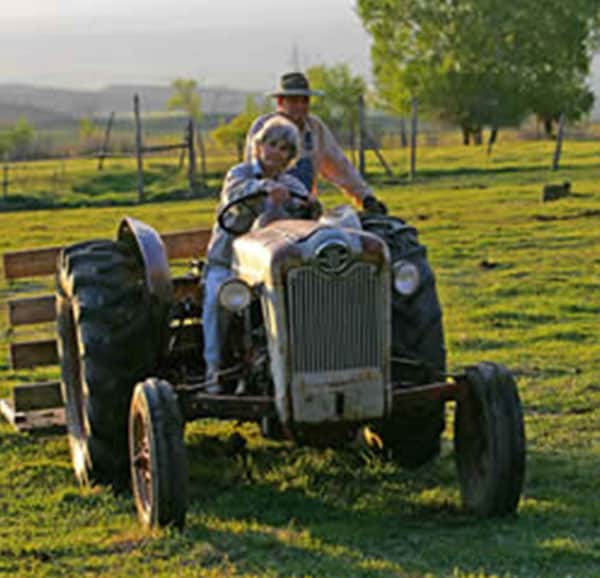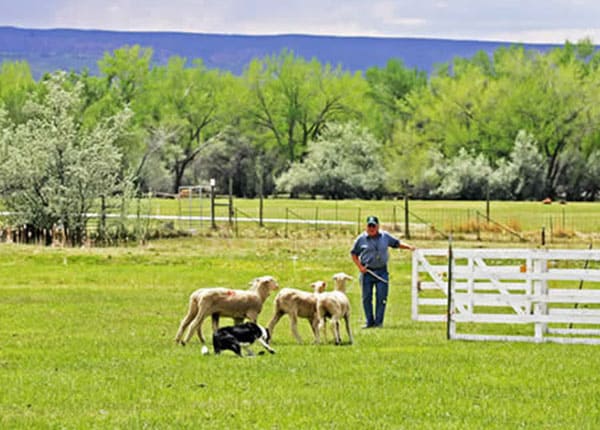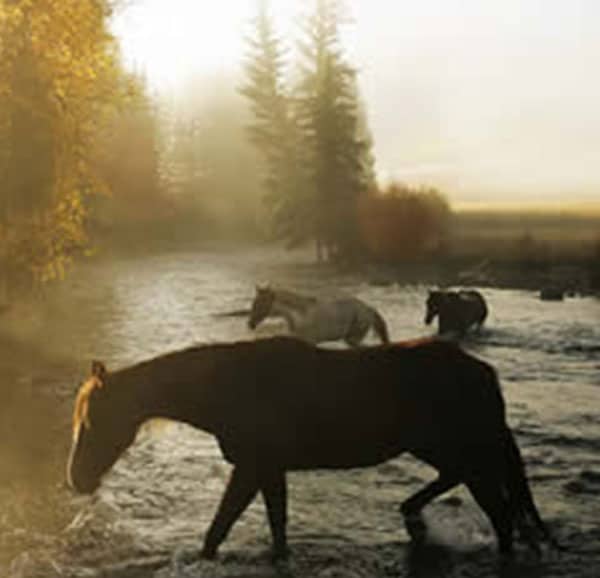THE NORTH FORK VALLEY—THE SEASONS OF THE YEAR
A locals narrative of the yearly calendar, weather, and happenings in the Crawford, Hotchkiss, and Paonia, Colorado region
SEASONS OF THE YEAR
WINTER
Typical winter weather patterns see fronts developing off the coast of Southern California and sweeping across the West. When this happens, you’ll quite often see Winter Storm Warnings posted for the southern mountains of Colorado. Indeed, places such as Telluride, Pagosa Springs, Creede, Gunnison, and Crested Butte might see up to two feet of snowfall in such an event. The North Fork Valley, in comparison, might get six or eight inches. Low temperatures in the winter average 10-15 degrees, with occasional cold snaps down to -20 to -25 degrees Fahrenheit in December and January, and very occasionally in February or March.

Most winters, there is little snow on the ground in the area between Crawford, Hotchkiss, and Paonia. Sometimes a prolonged cold spell will keep snow on the ground for a month or two at a time, but often the valley benefits from nice warm days that melt winter snow accumulations. It’s rare to have more than 8-10” of snow on the valley floor for any length of time. Spring calving season for cattle ranchers begins in February and lasts throughout March, with late calves being delivered into summer.
In 2008, however, it was a rough winter! Snow stayed on the ground from December 10, 2007, to the end of February–almost three months. In the last 20 years, this is an unusual occurrence. However, the old-timers will tell you that this is how it normally was in years past. We had an unusual amount of snow in 2008, and temperatures were low. Ranchers have had a hard time with calving, and ranchers have had to feed a lot of hay to both horses and cattle in the winter of 2007-08 that they normally wouldn’t have fed. (See my predictions on 2008 hay prices on www.mountainhay.com. I predict that hay prices will go up!)
Ranchers feed hay to their horses, cattle, sheep, and other livestock over the winter months, though many ranchers try to let their animals graze on hay stubble or unmowed pastures to avoid feeding valuable hay.

SPRING
Spring comes early to the North Fork Valley, with grass starting to turn green around the first of April. There can be a wide variety of weather conditions during the spring. April, May, and June are definitely the windiest months of the year, with gusts approaching 30 mph or more during windy periods. The prevailing wind is from the southwest, and because there is a wide expanse of open range with few mountains for a long way to the west, there’s nothing to stop the wind. However, the wind usually abates by mid-summer to quiet levels.
One of the biggest challenges of the spring is getting the fruit trees through their blossoming and pollination period in late April and early May. If a late freeze comes, the fruit crop could be frozen for that year. Many growers have windmills and smoke blowers to try to keep the air moving in the orchards and avoid freezing the crops. There is also danger of freezing hay crops as well, a fact of which many people are unaware.
Precipitation can come in the form of either rain or snow, depending, of course, on the temperature. Storms can move in quickly and violently, with alternating periods of rain, snow, sunshine, and then more precipitation. Days can be either balmy and warm or cold and muddy. Sheep growers are busy delivering their lambs during March and early April.

SUMMER
Summer comes quickly in the North Fork Valley. Farmers are busy spreading irrigation water on their fields as thoroughly as possible before the snowmelt abates. Cherries ripen early, and are ready in late June. Coincidentally, mountain grass hay is ready for the first cutting of the year at about this time. Downvalley in Delta, alfalfa hay can be ready to cut as early as the beginning of May, but in the Hotchkiss/Paonia/Crawford area, the first cutting is usually in the month of June. Some farmers in Paonia are able to cut lush stands of hay in the first of the month, but most often, the ideal cutting date for Crawford hayfields is June 25. If you’re curious about growing hay and the cost of haying equipment, LINK to my article on Colorado ranch real estate and haying equipment at www.aspenranchrealestate.com.
Crawford’s Pioneer Days celebration takes place the second weekend in June, with Paonia’s Cherry Days coming around on the Fourth of July weekend. Hotchkiss hosts the annual North Fork Bluegrass and Roots Festival on the weekend of Jun 13-15, 2008.
Wild asparagus grows on the ditch banks on many ranches, and it’s a popular pastime for many locals to gather a bag full of fresh organic wild produce and celebrate the beginning of summer. The asparagus begins to get tall and woody as the summer goes on.
Ranchers begin moving their cattle up to the lower foothills in May, and on to the higher ranges in the mountains in mid-June.
There is usually a dry spell in the first part of June, often lasting through the 21st or so, and then the summer rains begin. A big rain in the North Fork Valley is anything over an inch, which happens usually only once or twice a year. Farmers watch the weather channels carefully to avoid having hay on the ground with a weather system approaching. Once the summer rains begin, they’re usually fairly predictable, with afternoon and evening thundershowers as the boilerplate forecast.
Apricots are the next fruit to become ready for harvest, followed by plums and then peaches. Make sure to patronize your local orchards for fruit and vegetables, as your summer business can make a big difference in their success.
Daytime temperatures can get hot in July and August, with highs close to 100 degrees. Farmers go out to irrigate in the cool of the early morning, and if you’re moving cattle, get an early start so the cows won’t get too hot. The annual Delta County Fair goes on for two weeks in August at the fairgrounds in Hotchkiss, and is highly recommended.

Fall
September and October are gorgeous months in the North Fork Valley, with cool nights and gorgeous balmy days. The leaves on the aspen trees, oak brush, serviceberry, and chokecherry begin to turn gold, russet, scarlet, and purple in mid-September. The peak of the fall colors is usually around September 25, and many people venture into the mountains to see the colors. The route over McClure Pass on Colorado 133, and the gravel road over Kebler Pass into Crested Butte are favorite spots to see the fall colors. The leaves fall to the ground with the first big snowstorm of the year, usually sometime in early to mid-October in the mountains.
In the valley, the colors turn a little later, with the fruit orchards and vineyards turning colors towards October. The narrowleaf and broadleaf cottonwoods of the riverbottoms turn golden in mid-October, and last until the beginning of November.
Ranchers begin moving their cattle from the high country to the home ranches in October and November. Typically ranchers sell their calves in November.
Hunting season is in full swing in the North Fork Valley, as a number of outfitters and guest ranches welcome their out-of-state hunters in search of elk, mule deer, and bear. Archery season begins in late August and goes through late September; muzzleloader season lasts for nine days in mid-September; and there are four rifle seasons, ranging from five to nine days, beginning around October 10 and lasting until around November 20. Hunting season is a very important part of the local economy, as well as the local table fare. In an area with a median household income of $31,800, an elk or deer in the freezer not only provides healthy, tasty meat, it also helps many families with their annual food budget.
The first freeze of the fall usually happens in September, allowing the apples and grapes to sweeten before harvest.
November begins to get colder, and deer migrate down to the lower elevations. The cold winds of the first snowstorms strip the leaves off the cottonwood trees, and by mid-November, the winter is coming on.
A little-known fact about the North Fork Valley is the excellent upland bird and waterfowl hunting that can be found here. There are wild bird populations of pheasant and chukar in the valleys and canyon rims of the Smith Fork and the Gunnison, and excellent populations of blue grouse in the mountains. Waterfowlers can hunt the Gunnison River, and there are several local ponds and sloughs that offer good shooting on ducks and geese. For released bird hunting, there are several shooting preserves that offer excellent habitat for pheasants, chukar, quail, and Hungarian partridge. Certain ranch properties have wild pheasant populations present.
Many days of the year are sunny in the North Fork Valley—about 70% of the days in a year are sunny. Average annual precipitation in the North Fork Valley varies from 15 to 24 inches, so the climate is considered arid. Humidity ranges from 80% on a stormy afternoon in the summer to 10% on a dry winter day.
Call me if you have questions about the North Fork Valley and the real estate opportunities to be found here. I specialize in ranch and agricultural properties, but I also have a strong knowledge of residential real estate.

